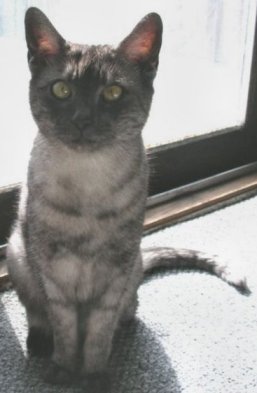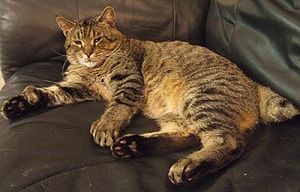 |
| Vital Statistics: |
| Place of Origin: Egypt |
| Coat Type: medium long, fine, silky |
| Color: silver, bronze or smoke, all with spots & stripes even in skin pigment |
| Temperament: intelligent, athletic, loyal, curious, does not get along with other cats or pets |
Where does the Egyptian Mau come from?
Cats were worshiped and protected in ancient Egypt, during the time of the Pharoahs. Today that is not the case and many of these cats are mistreated. In 1956, exiled Russian Princess Nathalie Troubetskoy brought an Egyptian Mau kitten to the U.S. from Egypt via Rome where it has become a popular pet. In the Egyptian Book of the Dead, the sun god Ra was depicted as a spotted cat that struck down the evil serpent of darkness. The Mau is the oldest breed of cat known and the only cat with a naturally occurring spotted coat.
What does the Egyptian Mau look like?
The Egyptian Mau has a lithe muscular body, medium in length. Its almond eyes are light green. Ears are large with moderate points. The fur is fine and silky, medium long. The coat is a transition between spots and stripes which show in the skin pigmentation as well. Coat colors are silver, bronze and smoke. Minimal grooming is required.
Does the Egyptian Mau make a good pet?
The Egyptian Mau is extremely loyal , very curious and intelligent. It learns tricks quickly and easily. It does not do well with other cats and pets. The Egyptian Mau doesn’t care to be a lap cat although it is very devoted to its owner. It is very athletic, jumping high and is the fastest running domestic breed. It tends to find warm spots in the house, so is really an indoor cat. The Mau is a lively great pet.
Where can I adopt an Egyptian Mau?
There is an organization in Egypt called “EMRO” that is trying to save this endangered breed. Other organizations where adoption is possible are as follows:
EMR – contact: Dorothea Brocksom tel. 360 825 1009
Cat Purebred Rescue – e-mail- [email protected]
Paws of Gold Feline Rescue – e-mail – [email protected]
Possible Health Issues
Patellar luxation, sensitivity to anesthetics, vaccines and pesticides, cardiomyopathy.



